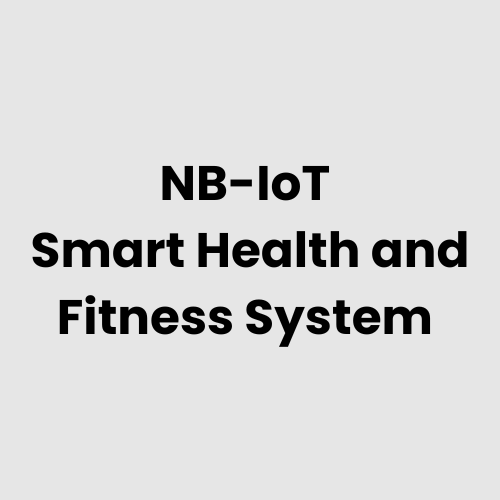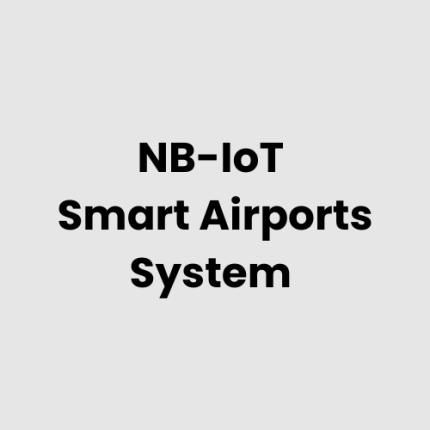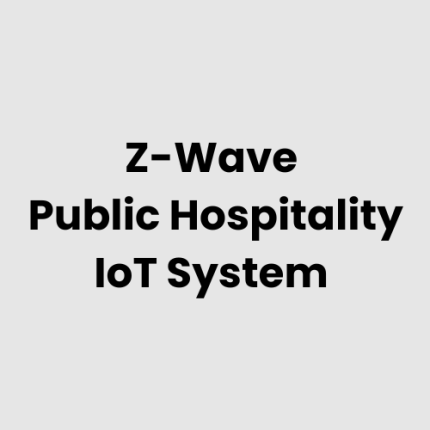Description
NB-IoT Enabled Smart Health and Fitness System
Technical Architecture
The NB-IoT Enabled Smart Health and Fitness System from GAO Tek is designed to revolutionize personal health and fitness management by leveraging the power of NB-IoT (Narrowband IoT) technology. The system provides real-time monitoring of various health metrics, securely transmits data for analysis, and helps optimize fitness regimens with minimal effort from users. The architecture integrates sensors, edge computing, connectivity, cloud services, and data analytics into a seamless solution for tracking health and fitness parameters.
- Sensor Layer:
- Wearable Health Sensors: These include heart rate monitors, ECG sensors, SpO2 sensors, temperature sensors, and accelerometers. These sensors collect real-time health and fitness data like heart rate, physical activity, oxygen levels, body temperature, and sleep patterns.
- Environmental Sensors: Track ambient temperature, humidity, and air quality, which can influence physical performance and health.
- Activity Trackers: Detect movements, steps, and workouts, providing users with actionable insights into their fitness goals.
- Connectivity Layer:
- NB-IoT Gateways: NB-IoT gateways facilitate low-power, wide-area network communication. These devices collect and transmit data from the health and fitness sensors to cloud platforms, ensuring reliable, continuous connectivity even in low-coverage areas.
- Edge Computing Layer:
- Local Data Processing: Edge devices handle preliminary data processing, filtering, and analysis before sending the data to the cloud. This ensures real-time feedback and minimizes latency in critical health data processing.
- Cloud and Data Management Layer:
- Cloud Integration: Cloud-based platforms aggregate, store, and analyze health and fitness data over time. By analyzing patterns and trends, the system provides deep insights into the user’s health progress.
- Analytics and Control Layer:
- Data Dashboards: Display real-time metrics for health and fitness, offering easy-to-read visualizations.
- Health Monitoring Algorithms: Use machine learning to track and predict health conditions, suggesting optimal fitness plans based on real-time data.
- Notifications & Alerts: Automated alerts notify users of abnormal readings (e.g., high heart rate) or suggest actions based on health conditions, like resting or hydrating.
List of Hardware
- Wearable Health Sensors:
- Heart Rate Monitors: Measure heart rate in real-time.
- ECG Sensors: Provide data for heart health and can detect abnormalities like arrhythmias.
- SpO2 Sensors: Measure blood oxygen levels to assess respiratory health.
- Temperature Sensors: Monitor body temperature for detecting fever or hypothermia.
- Accelerometers: Track physical activity levels, steps, and movements during exercise.
- Environmental Sensors:
- Measure ambient conditions such as air quality, temperature, and humidity, providing context for fitness activities.
- NB-IoT Gateways:
- Low-power communication devices responsible for transmitting data from health and fitness sensors to local or cloud servers.
- Edge Computing Devices:
- Process real-time data locally, ensuring immediate response for certain health parameters.
- Smart Health Monitoring Devices:
- Fitness Bands and Smartwatches: Integrate health sensors for continuous tracking and display of fitness data.
- Smart Scales: Measure weight, body fat percentage, and BMI.
Physical Placement Considerations
- Wearable Sensors:
- These devices are worn on the user’s body, typically on the wrist, chest, or finger, ensuring continuous monitoring throughout the day. Placement should be secure, ergonomic, and comfortable for long-term wear.
- Environmental Sensors:
- These can be placed in fitness centers, gyms, or home environments to track external conditions like air quality and temperature, which can affect performance and health.
- NB-IoT Gateways:
- Gateways should be positioned to ensure optimal coverage and connectivity between sensors and the cloud. Typically, they are placed in areas where they can transmit data from multiple sensors simultaneously, such as in homes, gyms, or clinics.
- Edge Devices:
- These devices should be placed close to sensor clusters to minimize latency in data processing. They need to be protected from environmental factors, especially in fitness or outdoor scenarios.
Hardware Architecture
The NB-IoT Enabled Smart Health and Fitness System is structured with several key hardware components working together to ensure smooth operation and reliable performance:
- Sensor Layer:
- Composed of various sensors that collect real-time health and fitness data, including heart rate, steps, body temperature, and environmental conditions.
- Connectivity Layer:
- The connectivity layer enables communication between sensors and the gateway devices using NB-IoT, ensuring continuous and stable data transmission, even in low-signal areas.
- Edge Computing Layer:
- Local edge computing devices provide on-site processing of data, reducing the need for constant cloud interaction and enabling quick decision-making for health monitoring.
- Data Management Layer:
- Cloud infrastructure supports the storage, processing, and analysis of large volumes of data collected from multiple sensors. Advanced analytics and machine learning are applied to offer personalized health and fitness insights.
- Control and Automation Layer:
- Provides features like personalized health recommendations, fitness plans, and automated notifications (e.g., health warnings, hydration reminders) based on user data.
- Security Layer:
- End-to-end encryption protects sensitive health data throughout the data transmission process, ensuring compliance with industry regulations and privacy standards.
Deployment Considerations
- Network Coverage:
- Ensure NB-IoT coverage in areas where users will be located, especially for remote monitoring of patients or fitness tracking in areas with low coverage.
- Energy Efficiency:
- Sensors and devices should be designed for minimal energy consumption to ensure long battery life, particularly for wearables that are continuously used.
- Scalability:
- The system should be scalable to accommodate the growing number of users or devices, allowing for integration with additional sensors, fitness platforms, or healthcare systems.
- User Comfort:
- Wearable devices should be lightweight, ergonomic, and unobtrusive to ensure that users can wear them comfortably during daily activities or intense workouts.
- Data Privacy and Compliance:
- All health data should be securely encrypted, and the system must comply with regulations such as HIPAA (Health Insurance Portability and Accountability Act) for user data privacy.
- Customization:
- The system should allow customization based on individual health goals, fitness needs, and medical conditions, providing personalized insights and alerts.
List of Relevant Industry Standards and Regulations
- HIPAA – Health Insurance Portability and Accountability Act
- ISO 13485 – Medical device quality management
- ISO/IEC 27001 – Information security management
- IEC 60601 – Medical electrical equipment standards
- FDA 21 CFR Part 820 – Medical device regulations
Local Server Version
For areas with limited or no cloud access, the NB-IoT Enabled Smart Health and Fitness System can be configured to run on a local server. This version offers several advantages, including:
- Data Processing Locally:
- Real-time data from health sensors can be processed locally, ensuring that users receive immediate feedback without relying on an internet connection.
- Reduced Latency:
- By processing data on-site, the local server ensures faster response times for critical health monitoring, such as heart rate or ECG alerts.
- Increased Data Control:
- With a local server, all health data remains on-site, which can enhance privacy and security, particularly in sensitive healthcare environments.
- Offline Functionality:
- The local server ensures that the system remains operational even when internet connectivity is interrupted, ensuring continuous health monitoring.
- Cloud Integration and Data Management
- Data Aggregation and Analytics:
- Cloud-based platforms aggregate data from sensors and wearable devices, storing large volumes of data for long-term analysis. These platforms use advanced analytics to provide personalized health insights and predictive recommendations.
- Real-Time Monitoring:
- Cloud integration allows health professionals and users to monitor fitness metrics and health conditions remotely, providing real-time alerts and notifications for abnormal readings.
- Scalability and Flexibility:
- The cloud environment supports the scalability of the system, making it easy to add more devices, users, or sensors without significant infrastructure changes.
- Data Security:
- Data in the cloud is encrypted, ensuring that sensitive health and fitness data is protected from unauthorized access and ensuring compliance with regulatory standards.
- Integration with Third-Party Platforms:
- Cloud services allow seamless integration with other health apps, fitness tracking platforms, and healthcare management systems, enabling a holistic approach to personal health management.
GAO Case Studies of NB-IoT Enabled Smart Health and Fitness System
USA Case Studies
- New York City, New York
In New York City, NB-IoT technology is used in smart fitness tracking systems to monitor vital signs such as heart rate, blood oxygen levels, and physical activity. Real-time data is sent to healthcare providers, enabling personalized fitness plans and immediate interventions when necessary. GAO Tek solutions enhance health management and fitness optimization. - Los Angeles, California
In Los Angeles, NB-IoT is utilized in wearable devices that track user fitness data, including steps, calorie consumption, and sleep patterns. The system sends real-time data to a cloud platform where health experts can analyze and provide personalized recommendations. GAO Tek’s solutions help users stay on top of their health goals and improve overall wellness. - Chicago, Illinois
Chicago leverages NB-IoT to enhance gym management systems. Smart equipment monitors workout progress, provides real-time feedback, and tracks members’ fitness levels. The system optimizes gym operations, providing data to tailor workouts based on user performance and preferences. GAO Tek’s technology boosts user engagement and fitness results. - San Francisco, California
In San Francisco, fitness centers use NB-IoT to provide personalized workout routines and monitor user progress. Smart devices measure and transmit data about user performance during exercises, helping trainers adjust routines accordingly. GAO Tek’s system helps fitness enthusiasts reach their goals efficiently by providing real-time insights. - Miami, Florida
Miami utilizes NB-IoT for elderly health monitoring in fitness programs. Wearable devices track physical activity, heart rate, and other key indicators, with data sent directly to caregivers. This enables caregivers to monitor elderly individuals remotely and ensure their health is on track, promoting a safer environment for active seniors. - Dallas, Texas
In Dallas, NB-IoT technology is used in a smart health platform for chronic disease management. Patients wear devices that monitor physical activity, medication adherence, and vital signs. Data is sent to medical providers for real-time monitoring, enabling timely interventions and better health outcomes. GAO Tek supports patient health and well-being with smart tech. - Houston, Texas
In Houston, NB-IoT is implemented in smart healthcare devices that track physical activity and biometric data in patients with heart conditions. The system sends real-time health data to medical professionals, enabling immediate action when irregularities are detected. GAO Tek’s solutions enhance heart health monitoring and intervention. - Atlanta, Georgia
In Atlanta, fitness centers use NB-IoT to enhance member experience through smart gym equipment. The equipment tracks performance, including repetitions, weight lifted, and calories burned, sending this data to personal devices. This creates a more personalized and efficient fitness plan for each gym member. - Boston, Massachusetts
In Boston, NB-IoT is used in wellness monitoring systems for corporate offices. Employees wear devices that track physical activity, sleep patterns, and stress levels. The data is analyzed and used to offer personalized wellness programs, improving overall employee health and productivity. GAO Tek’s solutions help businesses maintain a healthier workforce. - Seattle, Washington
In Seattle, NB-IoT is used for monitoring patients’ fitness and recovery progress after surgery. Wearable devices track physical activity and health metrics like range of motion, which are sent to healthcare providers for monitoring. GAO Tek technology enhances postoperative care and recovery efficiency. - Denver, Colorado
Denver uses NB-IoT in a smart fitness program that tracks outdoor physical activities such as hiking, cycling, and running. Devices monitor user vitals, including heart rate and oxygen levels, and send data to a cloud platform for health analysis. This data helps users optimize their outdoor fitness experience. - Phoenix, Arizona
In Phoenix, NB-IoT sensors are incorporated into fitness wearables that measure hydration levels, heat stress, and physical activity in athletes. The collected data is analyzed to provide insights into performance and help prevent overexertion, especially in extreme heat conditions. GAO Tek’s solutions aid athletes in maintaining peak performance. - Minneapolis, Minnesota
Minneapolis uses NB-IoT to manage wellness programs for senior citizens. Wearable devices monitor physical activity, heart rate, and fall detection, ensuring seniors remain active and healthy. The data is shared with caregivers, allowing them to act quickly in case of any emergencies. GAO Tek’s technology ensures seniors stay connected and healthy. - Washington, D.C.
In Washington, D.C., NB-IoT is used for sports performance tracking in elite athletes. Devices monitor a wide range of metrics, including heart rate variability and recovery patterns, helping athletes optimize training. The real-time data provides coaches with critical information to fine-tune training programs. - Orlando, Florida
Orlando employs NB-IoT for fitness tracking in public health campaigns. Wearable devices monitor daily physical activity and nutrition, helping individuals set personal health goals. The system enables public health authorities to gather data to evaluate fitness programs and improve community health.
Canada Case Studies
- Toronto, Ontario
In Toronto, NB-IoT is applied in fitness wearables to monitor heart rate, stress levels, and daily activity. The data is uploaded to cloud platforms, allowing fitness trainers to tailor workouts according to individual progress. GAO Tek’s solutions enhance personalized health and fitness routines for users. - Vancouver, British Columbia
Vancouver uses NB-IoT in smart health devices for elderly fitness programs. These devices monitor mobility, heart rate, and physical activity, sending real-time data to caregivers. This helps ensure elderly individuals maintain a healthy, active lifestyle with remote monitoring. GAO Tek plays a key role in advancing health management for seniors.
Navigation Menu for NB-IoT
Navigation Menu for IoT
- LORAWAN
- Wi-Fi HaLow
- Z-WAVE
- BLE & RFID
- NB-IOT
- CELLULAR IOT
- GPS IOT
- IOT SENSORS
- EDGE COMPUTING
- IOT SYSTEMS
Our products are in stock and can be shipped anywhere in the continental U.S. or Canada from our local warehouse. For any further information, please fill out this form or email us.
We are actively looking for partners who are like us located in the U.S. and Canada. For more information on partnering with GAO, please visit Partner with GAO Tek Inc. It lists various ways to partner with GAO, such as OEM Partnerships, Technology Integration, Distribution and Reselling Opportunities, Presenting at the Leading Event Tek Summit, Joint R&D Projects, Training and Consulting Services, Industry-Specific Collaborations, Research and Academic Partnerships.



